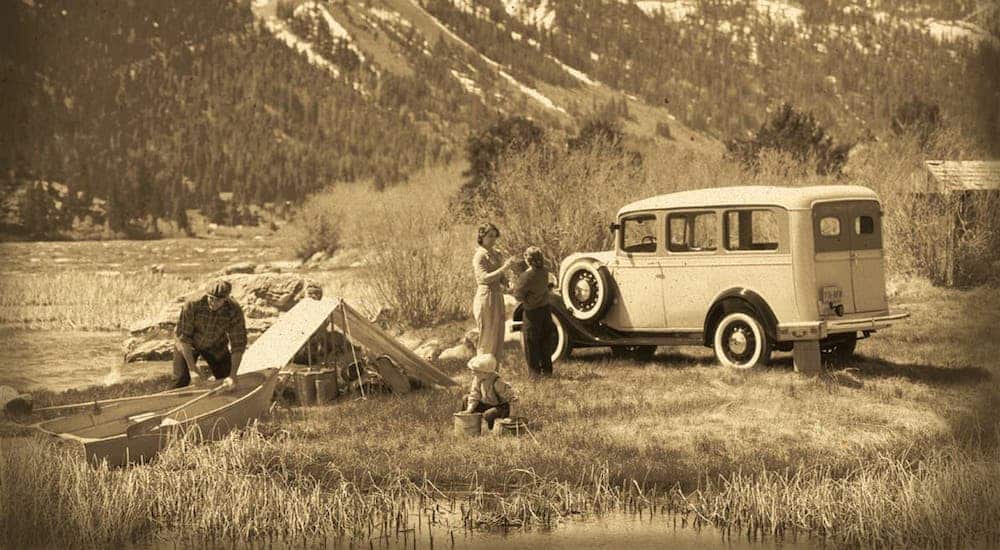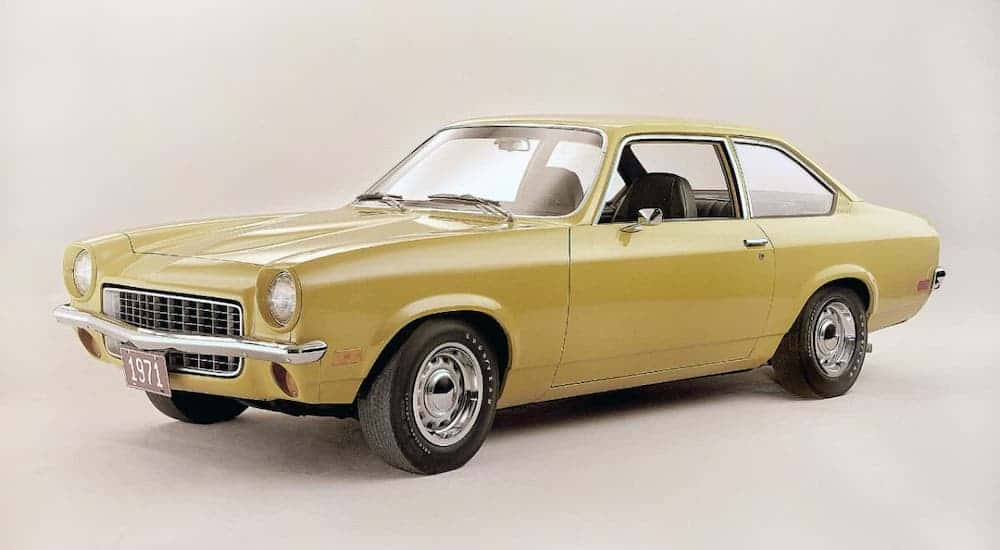Heritage. History. Tradition. These are just a few words that come to mind when thinking about the iconic American Chevrolet brand. Starting with the design and production of Chevy’s C Series model in 1913 and continuing to this day with a large lineup of American-made vehicles in virtually every category, it’s hard not to notice the thread of legacy and long history woven into every vehicle. From the exciting, dynamic Corvette to the powerhouse Suburban and even the sometimes forgettable little Aveo, Detroit-based Chevrolet continues its long tradition of proudly designing a wide range of vehicles of all sizes and styles, and at all price points, for the American consumer. And because of Chevy’s long-standing history of loved vehicles, it may be worth visiting your local Chevy dealership to get acquainted with today’s Chevrolet brand. But before you do, here’s a little bit of history on the brand and its evolution over the last 100+ years.
How it All Began
Now part of the General Motors family of brands, Chevrolet was founded in 1911 by Louis Chevrolet, a Swiss race car driver and automobile engineer, and financier William Durant. The first C Series vehicle designed, hit the production line in 1914 and included the now globally recognized “bow tie emblem” that Chevy still uses on its vehicles today.
Highs and Lows
Every auto manufacturer launches successful models and, let’s say, not so successful models. These highs and lows are part of the process of innovating. The existence of a few clunkers tells us that Chevrolet’s team of designers and engineers pushed the envelope and kept an ear to the ground for trends and consumer preferences. And the fact that all of their designs weren’t met with full success is merely a side effect of out-of-the-box thinking. Unfortunately, Chevy dealers took the brunt of the fallout, with many well-intentioned models sitting on the lot unsold. Conversely, many models – such as the Corvette – continue to hold their place as aspirational, sought after status symbols. Here are our picks for the best, and the worst, Chevy models ever made:
The Five Best Chevy Models
-
- Suburban: This full-sized SUV’s name is the longest continuously running nameplate in automotive history. The Suburban name first appeared in 1934 and continues to be used today. The Suburban is one of Chevy’s most profitable vehicles. Currently, in its eleventh generation, today’s popular Suburban offers the perfect marriage of workhorse and style.
- Impala: Debuted in 1958, the Impala has had a stop/start history of production. Model years spanned 1958-1985, 1994-1996, and again from 2000-present. Commonly identified as a performance sedan, the Impala was a sales leader for Chevrolet, with the 2014 Impala designated as the top-selling car in its class. Positioned as a high-performance sedan, even the 2006 Impala offered 303 horsepower 5.3L V8 motor.
- Camaro: The beloved Camaro enjoys a storied history in the Chevrolet vehicle family. Its highly recognizable design and impressive performance ratings land it squarely on the list of ‘pony car’ favorites. Launched in 1967 to compete directly with the successful Ford Mustang, Camaro took the auto industry by storm. Over the years, we’ve seen coupes, t-tops, and convertibles; but throughout its history, car enthusiasts agree that the Camaro deserves its place as one of the most admired vehicles in American automotive history.
- Silverado – Chevy dealerships always keep a large inventory of Silverado pickup trucks on their lots, and for a good reason. This top-selling truck line is a foundation of the Chevrolet line. Silverado replaced the C/K line in 1999 and is currently in its fourth generation. The line offers light duty (1500) and heavy-duty (2500, 3500) options.
- Corvette: More than 60 years and eight generations of design comprise the history of Corvette. With its hallmark fiberglass body design, this two-door sports car distinctively occupies its space among the elite Detroit Muscle Cars of its time. Easily Chevrolet’s most aspirational model, the Corvette continues to push the boundaries of performance vehicle innovation. For 2020, Corvette’s engine migrates from front- to mid-engine design, the first such design since 1984’s Pontiac Fiero. The 2020 Corvette Convertible was launched at the Kennedy Space Center, a fitting celebration for “America’s Sports Car.”
The Five Worst Chevy Models
- Vega: From earning Motor Trend’s 1971 Car of the Year to its less-than-noble demise just six years later, the Chevy Vega is one vehicle Chevrolet would like to forget. Plagued with significant reliability, safety, and durability issues, the Vega also became infamous for its tendency to rust. Sadly the Vega caused some short-term damage to General Motors’ reputation, but the damage was short-lived.
- Corvair: The name Corvair comes from a blend of Corvette and Bel Air. Chevrolet launched this model with several body styles, including a sedan, coupe, convertible, and station wagon. Positioned to compete with the Plymouth Valiant and Volkswagen Beetle, Corvair was launched in 1960. Corvair was the only Chevy vehicle with a rear-engine design, and the slant six engine was intended to help the vehicle achieve a lower profile for greater performance. Unfortunately, the rear engine created an imbalance that, at high speeds, reportedly caused a greater risk for accidents. In his book, “Unsafe at Any Speed,” activist Ralph Nader lambasted Chevrolet and the Corvair, ultimately creating a backlash that led to Chevy discontinuing the vehicle in 1969.
- Chevette: The subcompact Chevette replaced the Vega as Chevy’s entry-level offering in 1975 (just after the 1973 oil crisis and announcement of the new CAFE fuel economy standards) and went on to sell nearly three million units over its lifetime. Unfortunately, the automotive press wasn’t enamored with its design, engineering, or performance, so while the vehicle sold well and held its own against popular Japanese imports, it didn’t win any style points. Chevette bought GM time to redesign some of its larger, more popular vehicles, though, and played an essential role in establishing its relevance in the subcompact category.
- Citation: As a newly downsized compact launched in 1980, the Citation was the first front-wheel drive offering from Chevrolet. Early on, the Citation was one of Chevy’s most successful vehicles, with nearly two million sold during its run in the model lineup. Unfortunately, sales started strong – over 880 million sold in its first year – and dropped precipitously after that. Set to compete against the wildly popular Honda Accord, Chevy rushed to meet demand. But, unfortunately, myriad quality issues plagued the Citation, and as a result, it was discontinued just five years after its hugely successful launch.
- Geo Metro: There are mixed opinions on why GM chose to use the “Geo” name instead of badging the Metro as a Chevrolet. Some say Chevy did not want to put its name on an import, which is what the Metro was, and others claim the intent was to highlight this extremely fuel-efficient model. Either way, the only thing Metro really had going for it was its fuel economy, an astonishing 46 MPG on the highway, and 39 MPG in the city. Technologically and design-wise, the Geo Metro left a lot to be desired.
Today’s Chevrolet
Chevy has learned a lot from each vehicle’s success and failure. With over sixteen current vehicles in multiple categories and dozens of models to choose from, Chevy is better than ever. The company’s commitment to design innovation and environmental stewardship is evident in the all-electric Bolt, as is its long heritage of muscle car performance with the dynamic Camaro and the flagship Corvette. This 100-year tradition of producing exciting, headline-making cars and trucks is an amazing story of successful American manufacturing.






